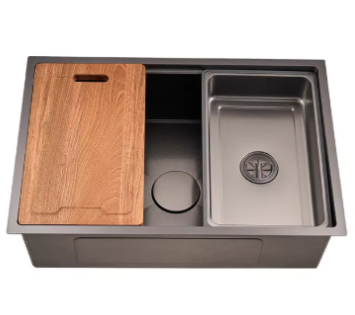Initial Investment vs. Long-Term Savings of Handmade Sinks
Upfront Costs of Artisan Craftsmanship
Handmade sinks definitely come with a bigger price tag right out of the gate. These artisan creations crafted from premium materials and featuring detailed designs usually cost anywhere between $300 up to around $2,000. Why so much? Well, they're not churned out on assembly lines like factory sinks. Each one gets its own special attention from skilled craftsmen, making every piece look different from the next. Homeowners thinking about remodeling their kitchens or bathrooms should really take note of these starting costs when setting aside money for the project. The reason behind the higher prices makes sense though the materials are top notch and the work involved takes way more time than regular manufacturing processes. Most people find that spending extra dollars upfront actually works out better in the long run since these sinks last longer and stand out visually compared to mass produced alternatives.
Reduced Replacement Expenses Over Time
Handmade sinks might cost more upfront but tend to save money down the road because they don't need replacing as often. These artisan crafted basins usually outlast factory made ones thanks to better materials and attention to detail during production. Some estimates suggest homeowners could save around 30 percent on replacement costs within ten years alone. The reason? They just don't chip, crack, or stain like cheaper alternatives do. When looking at the numbers, what matters most isn't the sticker price but how many times someone will have to shell out for repairs or new installations later on. For those thinking ahead financially, spending extra now on quality makes perfect sense when considering all those future dollars saved from not having to replace sink after sink.
Durability and Craftsmanship in Custom Sinks
Superior Materials for Extended Lifespan
Custom sinks tend to last much longer because they're built with really good stuff. Factory sinks? They usually cut corners on materials. Custom ones get made from things like copper, granite, or top shelf stainless steel instead. These materials aren't just strong, they actually stand up to everyday abuse without showing damage. Most people find that their custom sink resists rust spots and those annoying water rings that plague cheaper models. A properly cared for custom sink can easily make it past half a century in most homes. That means paying a bit more upfront actually saves money down the road when there's no need to replace every few years. Plus, these high quality materials don't just last longer, they look better too. Copper develops this beautiful patina over time while granite maintains its rich color without fading.
Handcrafted Construction vs. Mass-Produced Flaws
The difference between hand made sinks and factory produced ones really stands out when looking at quality. Artisans spend hours working on each sink, carefully shaping every curve and smoothing all surfaces so there are no blemishes like what happens with cheaper mass production methods. What makes these hand crafted pieces special is how they look amazing while still holding up well over time. Homeowners who choose handmade sinks tend to love them for years because the designs just seem better put together compared to store bought alternatives. Factory made sinks? Well, let's face it folks, those often come with little problems here and there that nobody notices until after installation. Chips in corners, uneven edges, sometimes even leaks develop down the road which means replacing them sooner than expected. So if someone wants something that looks great and lasts forever without constant fixing, going for a custom made sink might be worth the extra money spent upfront.
Aesthetic Value and Home Resale Impact
Unique Designs as Interior Design Assets
Nothing beats the impact of handmade sinks when it comes to creating standout design elements. These handcrafted fixtures grab attention in both kitchens and bathrooms thanks to the skill behind their creation. They turn ordinary rooms into something special, fitting right into today's decorating style where people want homes that feel personal rather than generic. Real estate agents will tell anyone who asks that houses featuring one-of-a-kind items like custom sinks tend to catch buyer interest faster in tight markets. Many professionals in the field point out that these unique pieces do more than just look good they bring a certain level of sophistication to any room while adding that extra something special that makes a house feel like a true home.
ROI Through Increased Property Appeal
Putting money into quality handmade sinks really pays off when it comes to getting good returns on property investments. Real estate numbers back this up too many homes featuring one-of-a-kind items like custom crafted sinks tend to fetch higher prices when sold. Some studies show that kitchens or bathrooms renovated with these special sinks can bring back between 80% to even 100% of what was spent. These beautifully made sinks catch buyers' eyes and make a big difference in how people view a home overall. Homeowners looking to maximize their profits should consider adding these artistic elements since they not only look great but also help increase market value substantially.
Maintenance and Sustainability Considerations
Eco-Friendly Production Practices
Artisans who craft handmade sinks tend to focus heavily on green manufacturing approaches. Most will hunt down reclaimed wood, recycled metals, or other environmentally conscious materials for their creations. Their workshops run on systems designed to cut down on scrap and energy usage throughout the whole process. According to recent surveys, shoppers nowadays care way more about where their stuff comes from than they used to. People want to know if something was made sustainably before handing over cash. Handmade alternatives generally need fewer resources during production when compared to factory-made counterparts. This makes them pretty attractive right now as folks across the country try to shrink their carbon footprints without sacrificing quality bathroom fixtures.
Low-Upkeep Advantages of Quality Materials
When it comes to keeping things clean and looking good, handmade sinks really stand out because they're built with better stuff right from the start. Most people know these kinds of sinks last longer and don't get stained or scratched as easily as other options do. The fact that they hold up so well actually saves folks both time and cash in the long run compared to those cheap plastic or thin metal sinks that need constant attention. Think about it this way: someone who buys an artisan sink might only need to polish it once every few years instead of dealing with daily cleaning headaches. And let's face it, nobody wants to spend weekends scrubbing away at bathroom fixtures when there are so many other things to do around the house.
Handmade vs. Factory-Made Sinks: Cost-Benefit Breakdown
Comparing Lifetime Costs Across Sink Types
Looking at the total cost of ownership for handmade versus factory made sinks involves thinking about more than just what we pay upfront. Handcrafted sinks tend to cost more initially, but many people find they last much longer without needing repairs or replacements down the road. Factory produced models usually have that attractive low price point at first glance, though experience shows these often need fixing or replacing sooner because materials aren't as durable. Consumer feedback consistently points out how those cheap factory sinks start looking worn after just a few years while handmade versions maintain their appearance for decades. When shopping around for bathroom fixtures, it makes sense to factor in not only what fits our budget right now but also what will save money over time. Some homeowners who went for the pricier handmade option later realized they actually spent less overall compared to neighbors stuck constantly repairing their cheaper alternatives.
When Premium Pricing Equals Long-Term Value
To figure out if paying extra for handmade sinks actually pays off over time, we need to look at two main things: how good the materials are and how well they're made. From my experience, these aspects usually make sense when considering the price tag. Studies indicate people who spend more on handcrafted sinks tend to save money later because there's less need for repairs and they last much longer. We see this happening across different markets too, as shoppers become smarter about what they buy. More folks now understand that buying something decent quality might cost more upfront but saves headaches down the road. When customers realize their bathroom fixture won't crack after six months or leak constantly, they start seeing those initial dollars as smart money spent. This whole idea helps everyone make better choices between saving pennies today versus wasting dollars tomorrow.
FAQ Section
What is the typical price range for handmade sinks?
Handmade sinks typically range from $300 to $2,000, depending on the materials used and the complexity of the design.
How do handmade sinks lead to long-term savings?
Handmade sinks often provide long-term savings due to their durability and resistance to common damage, reducing the frequency and costs of repairs and replacements.
What materials are commonly used in custom sinks?
Common materials for custom sinks include copper, granite, and high-grade stainless steel, known for their strength and long lifespan.
Can handmade sinks increase my property's resale value?
Yes, handmade sinks can enhance a home's aesthetic appeal, making it more attractive in the real estate market and potentially increasing its resale value.
Are handmade sinks more environmentally friendly?
Many artisans use eco-friendly production practices for handmade sinks, sourcing sustainable materials and reducing waste, making them a more environmentally responsible choice.



